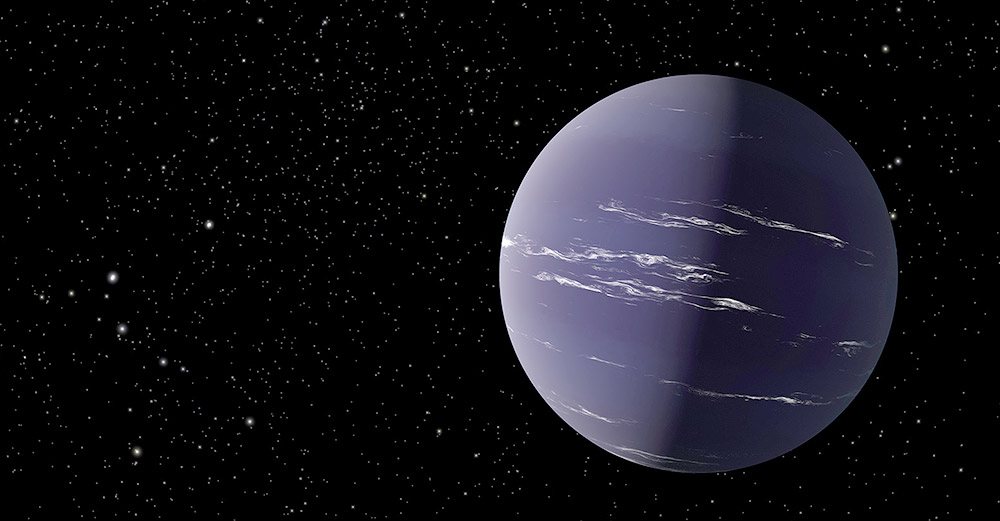Gas-rich, but mild: Almost 90 light-years away from us, an almost Neptune-sized, but potentially habitable exoplanet orbits a red dwarf – a previously rare type of extrasolar planet. The planet discovered by the TESS space telescope has a dense atmosphere that could give astronomers exciting first insights into the gas envelopes of exoplanets. In addition, the TOI-1231b baptized planet could reveal why there are no super-earths and sub-Neptunes in the solar system.
Astronomers have already discovered several thousand extrasolar planets – including around our closest neighbors Proxima Centauri and Gliese 887. It is noticeable that some of the planet types common in the cosmos are completely absent in our own solar system: We have neither super-earths nor sub-Neptunes. How these intermediate planetary sizes arise and why they sometimes develop a dense atmosphere and sometimes not, is still unclear.
Mild temperatures and only 89 light years away
A newly discovered exoplanet in our cosmic neighborhood could provide answers to these questions. TOI-1231b is only 89 light years away from us and orbits a red dwarf star. It has around 15 times the mass and 3.6 times the radius of the earth and is therefore slightly smaller than Neptune. Astronomers around Jennifer Burt from the California Institute of Technology tracked him down using images from NASA’s TESS (Transiting Exoplanet Survey Satellite) space telescope.
The special thing about TOI-1231b: Unlike many other exoplanets the size of just under Neptune, it circles in the habitable zone of its star – it offers potentially life-friendly, mild climatic conditions. “Although TOI-1231b is eight times closer to its star than Earth is to the Sun, its temperature is almost similar to that of Earth because its central star is cooler and fainter,” explains co-author Diana Dragomir from the University of New Mexico.
A water world?
With a mean surface temperature of around 330 Kelvin – around 56 degrees Celsius – the exoplanet TOI-1231b is one of the coolest and closest sub-Neptunes that astronomy has known to date. “TOI-1231b is one of very few planets of this size and in this temperature range,” says Burt. “Compared to most of the exoplanets discovered by transit so far, which are often hellishly hot, TOI-1231b is downright cold.”
The cooler Sub-Neptune are particularly interesting because there could be large amounts of water on them. In some exoplanets of this size, astronomers have already detected dense envelopes of water vapor. Due to the rather low density of some of these planets, some researchers even suspect that many sub-Neptunes could be water worlds – planets with global oceans.
Thick atmosphere – but from what?
Also exciting: The exoplanet could be one of the best candidates for gaining closer insight into the atmosphere of an alien planet. “The low density of TOI-1231b indicates that it is surrounded by a substantial atmosphere,” says Dragomir. “However, the composition and extent of this gas envelope are still unknown. It could have a thin, extended helium or hydrogen-helium atmosphere or a denser water vapor envelope. “
Which of these gases fill the shell of this sub-Neptune could not only give exciting insights into its atmosphere and living conditions. It also allows conclusions to be drawn about how this planet class is formed and whether the formation of planets around red dwarfs takes place differently than around more massive stars like our sun. “Because depending on the composition – whether hydrogen-helium or rather water vapor – this would indicate a different origin,” says Dragomir.
Targeted by Hubble and James Webb
Because TOI-1231b is relatively close to us and passes in front of its star, which is clearly visible in the infrared range, every 24 days, it could offer particularly good conditions for closer analyzes of its atmosphere. Such observations could reveal, for example, whether there are clouds in its gas envelope and what they are made of, as Burt explains. Later this month, the Hubble Space Telescope is supposed to direct its sharp telescope eyes on this planet and use the light shining through the gas envelope to find out more about the gas envelope of TOI-1231b.
The astronomers are hoping for even more detailed data from the James Webb space telescope, which will be launched into space at the end of this year. “This planet is one of the two or three nearby smaller exoplanets that we will study in every possible way and with a whole range of telescopes,” says Dragomir. “So there will soon be more news from TOI-1231b.” (The Astronomical Journal, in press; arXiv:2105.08077)
Quelle: University of New Mexico
–


